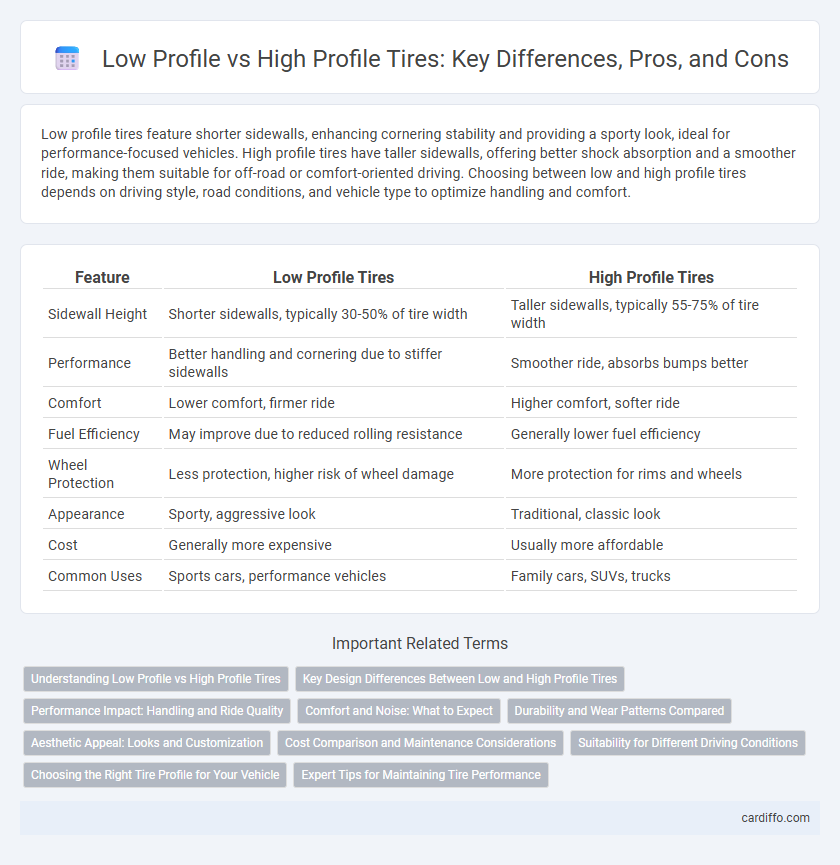Low profile tires feature shorter sidewalls, enhancing cornering stability and providing a sporty look, ideal for performance-focused vehicles. High profile tires have taller sidewalls, offering better shock absorption and a smoother ride, making them suitable for off-road or comfort-oriented driving. Choosing between low and high profile tires depends on driving style, road conditions, and vehicle type to optimize handling and comfort.
Table of Comparison
| Feature | Low Profile Tires | High Profile Tires |
|---|---|---|
| Sidewall Height | Shorter sidewalls, typically 30-50% of tire width | Taller sidewalls, typically 55-75% of tire width |
| Performance | Better handling and cornering due to stiffer sidewalls | Smoother ride, absorbs bumps better |
| Comfort | Lower comfort, firmer ride | Higher comfort, softer ride |
| Fuel Efficiency | May improve due to reduced rolling resistance | Generally lower fuel efficiency |
| Wheel Protection | Less protection, higher risk of wheel damage | More protection for rims and wheels |
| Appearance | Sporty, aggressive look | Traditional, classic look |
| Cost | Generally more expensive | Usually more affordable |
| Common Uses | Sports cars, performance vehicles | Family cars, SUVs, trucks |
Understanding Low Profile vs High Profile Tires
Low profile tires feature a shorter sidewall height relative to their width, enhancing handling responsiveness and cornering stability by reducing sidewall flex. High profile tires have taller sidewalls that provide improved ride comfort and better shock absorption on rough roads, making them ideal for off-road or rugged terrain conditions. Understanding the trade-offs between low profile and high profile tires helps drivers optimize performance, comfort, and safety based on driving style and vehicle requirements.
Key Design Differences Between Low and High Profile Tires
Low profile tires feature shorter sidewalls, providing enhanced handling, sharper cornering, and improved road feedback due to reduced sidewall flex. High profile tires have taller sidewalls that offer better shock absorption, increased ride comfort, and greater protection against road hazards like potholes. The key design difference lies in sidewall height, directly affecting tire performance, ride quality, and durability.
Performance Impact: Handling and Ride Quality
Low profile tires enhance handling by providing stiffer sidewalls and a larger contact patch, resulting in improved cornering stability and steering response. High profile tires offer a more cushioned ride by absorbing road imperfections, which increases comfort but can reduce precise handling. Choosing between low and high profile tires depends on prioritizing performance dynamics or ride quality for specific driving conditions.
Comfort and Noise: What to Expect
Low profile tires offer enhanced handling and sporty aesthetics but often sacrifice ride comfort and generate more road noise due to thinner sidewalls. High profile tires provide better shock absorption, resulting in a smoother, quieter driving experience, ideal for comfort-focused drivers. Choosing the right tire profile depends on balancing performance preferences with noise reduction and ride quality priorities.
Durability and Wear Patterns Compared
Low profile tires feature stiffer sidewalls that enhance handling but typically experience increased wear on the edges due to reduced cushioning. High profile tires offer greater sidewall height, resulting in better shock absorption and more even wear distribution across the tread. Durability tends to be higher in high profile tires as they better withstand impacts and resist sidewall damage compared to low profile tires.
Aesthetic Appeal: Looks and Customization
Low profile tires enhance aesthetic appeal by creating a sporty, aggressive look with minimal sidewall height, emphasizing wheel design and improving visual stance. High profile tires offer a classic or rugged appearance, allowing for larger sidewalls that can be customized with raised white letters or intricate tread patterns. Customization options vary, with low profile tires often paired with larger rims for a sleek, modern look, while high profile tires provide versatility for off-road or vintage-styled vehicles.
Cost Comparison and Maintenance Considerations
Low profile tires generally cost more initially due to their advanced construction and premium materials, while high profile tires tend to be more affordable and widely available. Maintenance for low profile tires can be more expensive as they are more susceptible to damage from potholes and curbs, often requiring frequent alignment and replacement. High profile tires offer greater durability and lower maintenance costs, making them a cost-effective choice for drivers prioritizing longevity and resilience.
Suitability for Different Driving Conditions
Low profile tires, characterized by shorter sidewalls and wider treads, offer enhanced handling and cornering performance, making them ideal for dry, smooth pavements and sporty driving. High profile tires feature taller sidewalls that absorb shocks better and provide improved ride comfort, favoring rough terrains, off-road conditions, and vehicles requiring better cushioning on uneven surfaces. Selecting between low and high profile tires depends on driving conditions, where low profile suits urban and performance-focused use, while high profile excels in durability and comfort on rugged or variable terrain.
Choosing the Right Tire Profile for Your Vehicle
Selecting the right tire profile involves balancing performance, comfort, and aesthetics based on your vehicle's specifications. Low profile tires, featuring shorter sidewalls, enhance handling and cornering precision but may sacrifice ride comfort and increase the risk of damage on rough roads. High profile tires offer better shock absorption and durability, making them ideal for everyday driving and vehicles requiring enhanced cushioning over uneven surfaces.
Expert Tips for Maintaining Tire Performance
Low profile tires offer enhanced handling and responsiveness but require careful monitoring of tire pressure and suspension alignment to prevent uneven wear and damage. High profile tires provide better cushioning over rough terrain, making regular inspection for sidewall damage and maintaining proper inflation essential for longevity and safety. Experts recommend rotating tires frequently and balancing wheels to optimize performance regardless of profile type.
Low Profile vs High Profile Infographic

 cardiffo.com
cardiffo.com